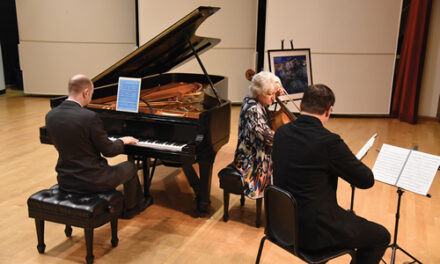While Wilmington Symphony Orchestra named their concert River Rhapsody as a nod to Schumann’s Symphony No. 3 (supposedly composed in tribute to the river Rhine) there is a deeper meaning at play whether intentional or not. A river, after all, exists in a constant state of change and transition, and the concert felt like a celebration of transition. With the announcement that conductor Steven Errante is retiring and a search for his successor is underway, the celebration of two bright young virtuosic talents was matched by a carefully curated selection of music that flowed between the Romantic and Modern eras.
Once everyone was seated and the sounds of tuning instruments died down, we were treated to the first piece of the concert, the overture to Oberon composed by Carl Maria von Weber. In the interest of transparency, overtures are some of my favorite pieces of music to listen to casually. The best overtures feel like buffets, sampling the motifs, movements, and overall soundscape of a composition, but they are still able to stand as independent pieces. Here, the effect of an overture for an opera we weren’t about to hear was a delightful one, something to stir the anticipatory spirit and demonstrate the sonic range of the orchestra. While, historically, Von Weber is just a few years shy of the Romantic period, the Oberon overture has enough flourish and power to feel at home with the romantics.
Following the overture, we were treated to two pieces (existing in that hazy space between Romantic and Modern) showcasing the winners of the Richard R. Deas Young Artist Concerto Competition, High School and UNCW divisions respectively.
First came Emily Bullard, performing the harp for Marcel Grandjany‘s Aria in Classic Style Op. 19. The piece proved a dazzling display of Bullard’s skill on the harp, a gentle but undeniably commanding presence. The harp is one of those instruments that is much harder to play than most people think; Grandjay’s aria favors higher strings and scale runs that are especially demanding. But like a truly skilled harpist, Bullard made it seem effortless.
Nicholas Strickland followed, an unassuming young man clad in a burgundy suit. He performed Alexander Glazunov‘s Concerto in E-flat Major specifically composed for the saxophone, Strickland’s weapon of choice. The saxophone was less than a hundred years old when this piece was composed for it, and it feels like a masterful showcase of what the instrument is capable of in an orchestral setting. However, it is a demanding piece, as the saxophone is already a physically taxing instrument and the concerto is over eleven minutes long with no breaks. Not that you would know how difficult it was from watching Strickland, as he rose to the occasion with a delightful flourish. The most striking moments for me were when the orchestra would play pizzicato underneath the sound of the saxophone exploring a range of sonic textures.
Bullard and Strickland are two young talents to watch for, and this writer wishes them luck in their future endeavors.
After the intermission, we ended the night with the piece for which the concert was named, Robert Schumann’s five-part symphony Rhenish. Dr. Errante began by carefully walking us through the piece, training our ears for what to listen for and deconstructing things just enough for us to appreciate them even more.
Rhenish is a spectacular piece in the hands of an orchestra like the Wilmington Symphony. It featured the brass in a way that was especially noticeable after an aria and a concerto that featured the strings. In the first movement Lebhaft (Lively), the horns were a welcome presence that added a fresh color to the sonic landscape. The contrasting tempos added a fresh and almost playful energy. The second movement, Scherzo: Sehr mäßig (Very Moderate) started out much slower, as if the composition itself was catching its breath from the first movement and readying itself for what was to come. Nicht Schnell (Not Fast) returned to a more string-heavy sound as it played with the contrasts between the first two movements and the last two. If Scherzo: Sehr mäßig felt like a moment for the orchestra to catch its breath, then Nicht Schnell felt like time to regain momentum, but slowly, steadily, with not a care in the world.
Feierlich (Solemn) contrasted the other movements, as it had a heavier texture with a subtle swell in the background that led into the final movement, also named Lebhaft. More than any other movement in the piece I could hear the metaphor of the river most clearly here, a rushing, climbing, leaping river. We could hear the contrasting tempos of the first movement, but with a fresh excitement as we neared the journey’s end. The music climbed and fell a few more times, before one last climb, and a crash, with only a moment of silence before the audience stood and applauded.
From these seemingly disparate elements, the Wilmington Symphony Orchestra crafted a truly unified orchestral experience. It was a night of perpetual, fluid, musical motion that celebrated liminality, the space between starting point and destination.











